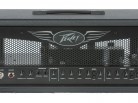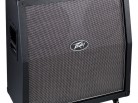I recently came across this amplifier on a fluke – a Craigslist ad with an unbelievable price. If the price is right I’m always willing to try new guitar gear out even if I already have equipment that fills that role. Enter the Valveking which I found in fantastic condition – one small tear in the vinyl covering of the amplifier head is all the wear this unit has had in its last year of duty of playing live shows with a soldier who will soon be deploying to Afghanistan.
At 100 watts the Valveking falls into the largest category of guitar amplifiers. This is not a low watt boutique amplifier that can sound like your favorite classic amp at lower volumes. No, this is a full fledged, fill a large area with sound amplifier. But this begs the question: Are 100 watt amplifiers becoming dinosaurs in this age? I ask this because a lower watt amp with a line out connection can be hooked directly to a sound board and the sound the guitar is producing played through a PA system. This usually leads to a more balanced sound if all the instruments of the band go through the PA system. We’ve all been there when two guitarists are dueling with their volume levels to get noticed – ruining the vocalists singing or smothering the sound of the drum kit or bass guitar. It happens, I’m guilty of it, but do amplifiers capable of these volumes even necessary?
Jim Marshall pioneered the idea of high wattage amplifiers in the 1960’s. Most amplifiers maxed at about 30 watts of output at that time and as rock musicians began to play larger and larger venues those size amplifiers weren’t cutting it. The story goes that the Who were the first to order high output amplifier with custom 8 speaker cabinets. This gave them the ability to play large venues. As time went on amplifiers became more and more complex – some solid state amps advertising up to 150 watts of power. What also happened simultaneously is that places like churches and clubs wanted to be able to provide sound in a more balanced manner with someone able to adjust sound levels. If you’ve ever been to a live show and stood directly in front of a musician with a high output amplifier good luck hearing another musician whose gear is only 30 feet to the left or right.
Features
The Valveking uses four 6L6 power tubes and three 12AX7 tubes in the preamp section. Pretty standard stuff but every amp has its own personality even if many of the features on the surface appear the same. The most interesting feature of this amp is the texture knob on the rear of the unit. Peavey claims fully rotating the knob counter clockwise will give you Class A amp (low power) performance and going all the way clockwise will give you Class AB amp performance (high power). The unit features a resonance and presence knob on the front of the unit – basically they dampen bass or treble in the preamp section. The amp can output to 4, 8, or 16 ohms output. Oddly – the cabinet can only accept 16 ohms. The cab only has one input – the second plug is to power an extension cabinet.
Solid state amps can produce almost linear sound – the sound remains the same as volume levels are increased. Because of that many manufacturers design their solid state amps to create overtones the way a tube amp does when it is driven hard. That brings up the question whether the extra maintenance of a tube amp is worth the trouble if a solid state amp can sound similar, often at a lower price.
First Impressions
Both the head and cab are made with birch plywood. Usually entry level equipment will feature MDF construction but Peavey built these units solidly. The previous user had removed the Peavey logos from the head and cab so I put them back on. That’s when I noticed that online pictures showed wings behind the logo on the cab – I like my ‘wingless’ look a lot better. The cabinet features real metal handles on the sides – most companies have gone with plastic which always shatter the first time you bump them on something. The cabinet features ¾” birch plywood construction and four Valveking speakers. This is one way manufacturers can save money – using house branded speakers.
The Clean Channel
Being a two channel amp I like to start with the clean channel. The clean and OD channel have separate treble, mid, and bass adjustments. I found the bass settings a little boomy with the stock cabinet on the clean channel. Turn down the bass and suddenly the sound is very pleasing. Treble and mid adjustments were very responsive. Peavey includes a treble boost button which I found a little shrill, but of course, it all depends what type of guitar and pedals you like to use. With a Les Paul on the neck pickup the treble boost was a good effect. A Stratocaster on the neck and middle position didn’t work well with treble boost – better to just use the bridge pickup. Again – it all depends on your style and setup but at least the feature is there in case you ever need it.
The resonance and presence controls don’t seem to do much on the clean channel and that’s ok. I’d rather dial in a sound using the EQ settings and then drive the section a little harder with an overdrive pedal. I think at the lower volumes I play at home there wouldn’t be impressive changes with the resonance and presence controls. At higher volumes and when recording I’m sure they are a nice addition. I generally kept them at about 10 o’clock (20%). Barely on – but it did smooth out the sound nicely compared to when they were off.
The OD Channel
You aren’t looking at a 100 watt tube amplifier unless you
intend to use the OD channel (at least in my book). The OD channel features a
volume boost button as well as a gain boost. Volume boost works well for solos
– the gain boost is pretty insane. It’s not a subtle option. Gain boost
thickens the sound tremendously. I suspect that this is not a tube driven
effect – I suspect a diode is involved in this one. Purists will scoff at that
– but
The gain produced by this amp is quite pleasing. At about halfway on the gain dial with the gain boost off your in classic rock territory. At about 75% on the dial the sound thickens nicely. At this setting you can experiment with a mid scoop – or even turning up the bass and lowering the mids and treble. You can get very nice variation with the EQ in the OD section – more so than with other lower end tube amps I’ve tried. Peavey spent a lot of time around the design of their EQ section and it shows. Keep turning up the gain dial and hit the gain boost and what is produced is very radical – too much for me but I know a lot of guys who keep their amps gain maxed at all times. For those guys this will be one of the sweetest out of the box sounds they can find. It’s not a 6505+ sound, but it is very, very good. Add an overdrive pedal in front of this and you have the makings for some very heavy sound.
Odds and Ends
I brought up the increased maintenance of a tube amp. All tubes will wear out with use. If you are very good to your tubes and allow the amp to warm up in standby before playing you’ll increase their life. The total tube life is totally dependent on how much and how hard you play. Most manufacturers no longer allow bias to be adjusted in their amps (the amount of current flowing to the power tubes). I checked the milliamps on the tubes after they had time to warm up and it seemed very low (a cold setting). This is great for tube life but I prefer a more middle of the road setting. I can get better tone more easily with a warm setting. Perhaps this is why the texture knob was not so impressive – there isn’t much power to turn down to begin with.
A useful trick on
The cabinet for this amplifier is of great quality. Birch construction, wheels provided from the factory, and those great Valveking speakers. Yes, these are very good speakers. I prefer them over the Celestion Seventy 80 speakers that so many entry level cabinets feature. Add solid handles and you have a great value in this cab. I only wish there was an option to change the input ohms so that I could try this cab with some different amp heads. It’s a cost cutting measure but I’d rather Peavey add $20 or $40 to the overall price for that option.
I had to lower my overall score for a couple of reasons. The very low factory bias setting limits the tones you can produce. With a warmer setting lower gain settings would have created a warm velvety tone – instead the tone doesn’t wake up until halfway up the gain dial. A warmer factory setting would have also made the texture knob the tool that it was designed to be. Imagine putting a dimmer switch on a 4 watt light bulb – not much change in total output as you rotate the dial. Lastly, the lack of input ohm adjustability limits this cab – I liked it enough I wanted to try it with a modified Crate head I have that produces beautiful Vox like sound but it only outputs 8 ohms. Also – if you add an extension cab at 16 ohms don’t forget to set your Valveking amp to 8 ohms.
The Peavey Valveking has an impressive price, great performance, and features. But it’s like a sports car that is limited by cheap tires. It could do so much more, but out of the box it can’t. If I could change only two things I’d say turn up that factory preset bias a little – I’m not even asking for adjustable bias at this price point. Second, let’s make that cab able to handle different amps in front of it.











